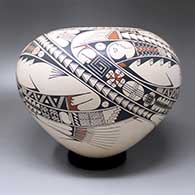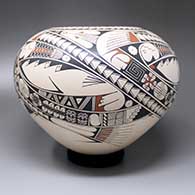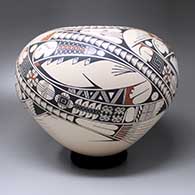
Click or tap to see a larger version
Ismael Flores Jr, Mata Ortiz and Casas Grandes, A polychrome jar decorated with a four-panel Mimbres geometric design
Mata Ortiz and Casas Grandes
$ 695
llcg3g298
A polychrome jar decorated with a four-panel Mimbres geometric design
8.75 in L by 8.75 in W by 7.25 in H Measurement includes stand
Condition: Very good
Signature: Ismael Flores
Tell me more! Buy this piece!
(505) 986-1234 - www.andreafisherpottery.com - All Rights Reserved
Ismael Flores Jr.
Mata Ortiz and
Casas Grandes
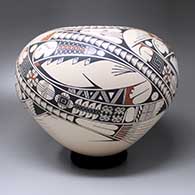
Ismael Flores Jr. is a potter from the area of Mata Ortiz in northern Mexico. He learned how to make pots in the late 1980s, first studying with his cousin, Manuel Rodriguez, then with his uncle, Jorge Quintana.
Ismael works with his wife, Maria Loya de Flores. She builds, sands and polishes the pots while he paints and fires them.
Mata Ortiz and Casas Grandes
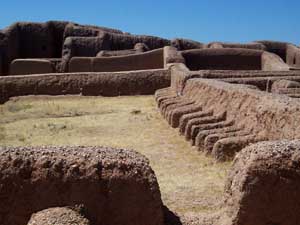
The macaw pens at Paquimé
Casas Grandes is both a municipality and an archaeological district in northern Chihuahua State, Mexico. The archaeological district includes the pre-historic ruins of Paquimé, a city that began to build around 1130 AD and was abandoned about 1450 AD. Archaeologists are uncertain as to whether Paquimé was settled by migrants from the Mogollon/Mimbres settlements to the north or by Anasazi elite from the Four Corners region in the United States or by others. Over the years Paquimé was built into a massive complex with structures up to six and seven stories high with multiple Great Houses in the surrounding countryside. Today, the site is a UNESCO World Heritage Site.
Mata Ortiz is a small settlement inside the bounds of the Casas Grandes municipality very near the site of Paquimé. The fortunes of the town have gone up and down over the years with a real economic slump happening after the local railroad repair yard was relocated to Nuevo Casas Grandes in the early 1960's. The town was in steady decline until Juan Quezada, a poor farmer who gathered firewood in the area of the archaeological site, was inspired by fragments of ancient Paquimé pottery and even older fragments of Mimbres forms with bold black-on-white designs littering the ground to learn more.
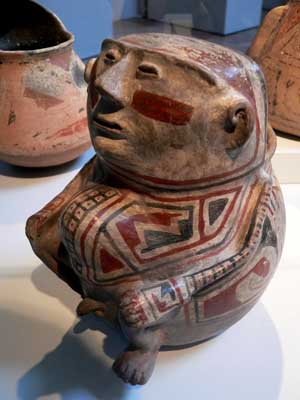
Ramos Polychrome effigy pot from Paquimé
Quezada was successful in his quest to learn to recreate the ancient process using slightly more modern techniques (although no one in the present tradition uses a potter's wheel). He learned to use sand and other coarse materials for temper. He discovered that dried cow dung made an excellent and inexpensive firing fuel. Instead of using gourds for smoothing he substituted broken hacksaw blades. Instead of using yucca fiber brushes for painting he learned to make brushes with human hair. He persevered in his efforts and by 1971 had produced a kind of polychrome pottery. Since then, most pottery-making in the area has used innovations in the design and decoration of the pots but the materials and the basic crafting of the process have remained the same.
By the mid-1970s, Quezada had attracted a significant number of traders and his work was becoming a commercial success. That is when he began teaching his techniques to his immediate family. They in turn taught other family members, friends and the younger generations. Both women and men were included from the beginning.
Originally called Casas Grandes pottery in the early years of its production, the potters of this tiny village have made such an impact on the pottery communities, including many awards and special recognition from the Presidents of Mexico, that Mata Ortiz pottery is now becoming known around the world.
Today, pottery production has changed the village in many ways as there is now electricity, plumbing, vehicles and more for the residents. Virtually everyone in the small town (2010 population: 1,182) makes their living by working in some part of the pottery-making process, from potters to clay-gatherers to firewood collectors to traders.
Mata Ortiz pottery incorporates elements of contemporary and prehistoric design and decoration, and each potter or pottery family produces their own distinctive, individualized ware. Young potters from surrounding areas have been attracted to the Mata Ortiz revival and new potting families have developed while the art movement continues to expand. Without the restraints of traditional religious practices or gender constraints, a vibrant flow of new ideas has enabled the pottery of Mata Ortiz to avoid the derivative repetition common to virtually all folk art movements. This blend of economic need, gender equality, cultural expression and artistic freedom has produced a unique artistic movement in today's community.

Lower photo is courtesy of David Monniaux, Creative Commons Attribution-Share Alike 3.0 Unported License
Mimbres Pottery
Mimbres Mogollon Culture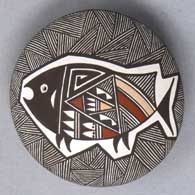
Rebecca Lucario
Acoma

Verda Toledo
Jemez
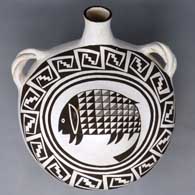
Marie Z. Chino
Acoma
The Mimbres Mogollon culture was named for the Mimbres River in the Gila Mountains. They lived in the area from about 850 CE to about 1150 CE. Substantial depopulation of the area occurred but there were many small surviving populations. Over time, these melted into the surrounding cultures with many families moving north to Acoma, Zuni and Hopi while others moved south to Casas Grande and Paquimé.
The time period from about 850 CE to about 1000 CE is classed the Late Basketmaker III period. The time period was characterized by the evolution of square and rectangular pithouses with plastered floors and walls. Ceremonial structures were generally dug deep into the ground. Local forms of pottery have been classified as early Mimbres black-on-white (formerly Boldface Black-on-White), textured plainware and red-on-cream.
The Classic Mimbres phase (1000 CE to 1150 CE) was marked with the construction of larger buildings in clusters of communities around open plazas. Some constructions had up to 150 rooms. Most groupings of rooms included a ceremonial room, although smaller square or rectangular underground kivas with roof openings were also being used. Classic Mimbres settlements were located in areas with well-watered floodplains available, suitable for the growing of maize, squash and beans. The villages were limited in size by the ability of the local area to grow enough food to support the village.
Pottery produced in the Mimbres region is distinct in style and decoration. Early Mimbres black-on-white pottery was primarily decorated with bold geometric designs, although some early pieces show human and animal figures. Over time the rendering of figurative and geometric designs grew more refined, sophisticated and diverse, suggesting community prosperity and a rich ceremonial life. Classic Mimbres black-on-white pottery is also characterized by bold geometric shapes but done with refined brushwork and very fine linework. Designs may include figures of one or multiple humans, animals or other shapes, bounded by either geometric decorations or by simple rim bands. A common figure on a Mimbres pot is the turkey, another is the thunderbird. There are also a lot of different fish depicted, some are species found in the Gulf of California.
A lot of Mimbres bowls (with kill holes) have been found in archaeological excavations but most Mimbres pottery shows evidence it was actually used in day-to-day life and wasn't produced just for burial purposes.
There's a lot of speculation as to what happened to the Mimbres people as their countryside was rapidly depopulated after about 1150 CE. The people of Isleta, Acoma and Laguna find ancient Mimbres pot shards on their pueblo lands, indicating that pottery designs from the Mimbres River area migrated north. There are similar designs found on pot shards littering the ground around Casas Grandes and Paquime near Mata Ortiz and Nuevo Casas Grandes in northern Mexico. Other than where they went, the only reasons offered for why they left involve at least small scale climate change. The usual comment is "drought" but drought could have been brought on by the eruption of a volcano on the other side of the planet, or a small change in the El Nino-La Nina schedule. Whatever it was that started the outflow of people, it began in the Mimbres River area and spread outward from there. Excavations in the Eastern Mimbres region (nearer to Truth or Consequences, New Mexico) have shown that the people adapted to new circumstances and that adaptation itself moved them closer into alignment with surrounding tribes and cultures. Eventually they just kind of merged into the background, although the groups that moved south and built up Paquime and Casas Grandes seem to have lost a war and survivors migrated to the west, to a land a bit more hospitable for them.
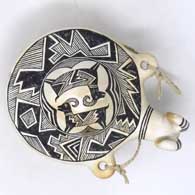
Michael Kanteena
Laguna
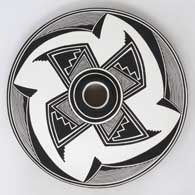
Paula Estevan
Acoma

Franklin Tenorio
Santo Domingo
Manuel Rodriguez Family and Teaching Tree - Mata Ortiz
Disclaimer: This "family tree" is a best effort on our part to determine who the potters are in this family and arrange them in a generational order. The general information available is questionable so we have tried to show each of these diagrams to living members of each family to get their input and approval, too. This diagram is subject to change should we get better info.
- Manuel Manolo Rodriguez Guillen (1972- )
- Ricardo Delgado Cruz & Sandra Lorena Arras
- Marta Gonzalez
- Ismael Flores Ledezma
- Ismael Flores Jr.
- Arturo Ledezma
- Efren Ledezma
- Juana Ledezma
- Rafael Ledezma
- Santos Ledezma & Rosa Loya
- Leticia Ledezma
- Leonel Lopez Sr. & Elena Rodriguez de Lopez
- Abel Lopez
- Leonel Lopez Jr.
- Uriel Lopez and Jesus Rodriguez Guillen
- Maribel Lopez
- Oralia Lopez
- Rosalba Lopez
- Yesenia Lopez
- Hugo Macias
- Alfredo Freddy Rodriguez & Diana Loya
- Emiliano Rodriguez Loya
- Armando Rodriguez & Olivia Mora de Rodriguez
- Abraham Rodriguez
- Luis Armando Rodriguez
- Graciela (Martinez) Gallegos & Hector Gallegos Sr.
- Guadalupe Gallegos (student)
- Hector Gallegos Jr. & Laura Bugarini
- Miriam Gallegos Martinez
- Julio Mora (1971-) & Alma Soto (1974-)
- Leticia Rodriguez Mora
- Oscar Rodriguez Guillen (1970-)
- Ruben Rodriguez & Martha Ponce de Rodriguez
- Teresa Tere Rodriguez
Copyright © 1998-2025 by

